Hardwood Floor Maintenance Tips To Keep Your Floors Looking New
Best Hardwood Floor Maintenance Practices for Long-Lasting Hardwood Floor Care
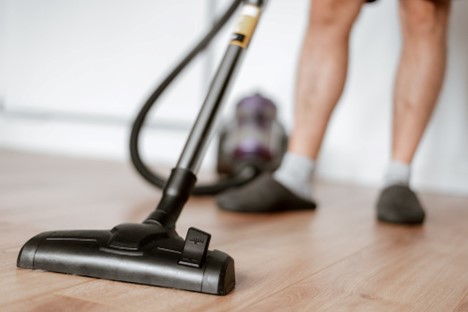
Image by Anete Lusina
Are you looking for ideas to keep your hardwood floors looking like new? Do you need some advice on the best hardwood floor maintenance practices? This helpful guide, inside this blog post, will provide all the tips and tricks you need to make sure your floor stays beautiful for years to come!
Understand Different Types of Hardwood
Hardwood comes in a variety of styles, finishes, and species. Solid hardwood is milled from a single piece of wood and is typically more expensive than engineered hardwood. Engineered hardwood is composed of wood layers laminated together. It is perfect for basements or other areas where moisture is present.
Different wood species have different hardness levels, as measured on the Janka Hardness Scale. Harder woods are more resistant to scratching and denting and are better suited for high-traffic areas. Species such as oak, maple, teak, and walnut have different characteristics that make them ideal for certain spaces. Knowing the wood species characteristics can help you make an informed decision when selecting flooring for your home.
Hardwood floor maintenance tip: Vacuum or Sweep Regularly
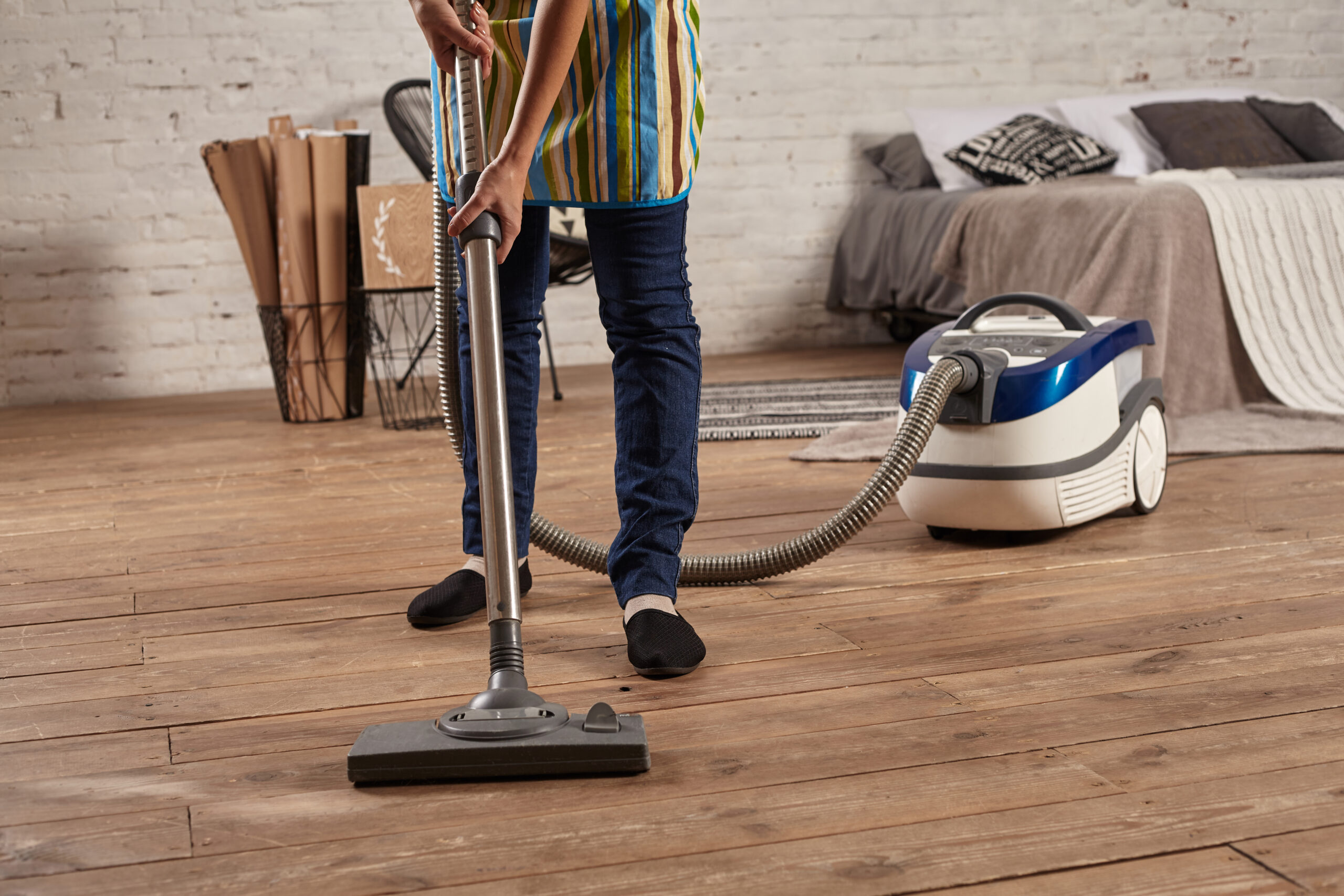
Faceless middle section of young woman using vacuum cleaner in home living room floor, doing cleaning duties and chores, meticulous interior. Young female working on house spring cleaning, indoors.
Image by Anete Lusina
When it comes to cleaning hardwood floors, regular vacuuming or sweeping is one of the most important steps. This helps to keep dirt and debris from building up in the cracks and crevices.
How often should you clean wood floors?
Routine cleaning
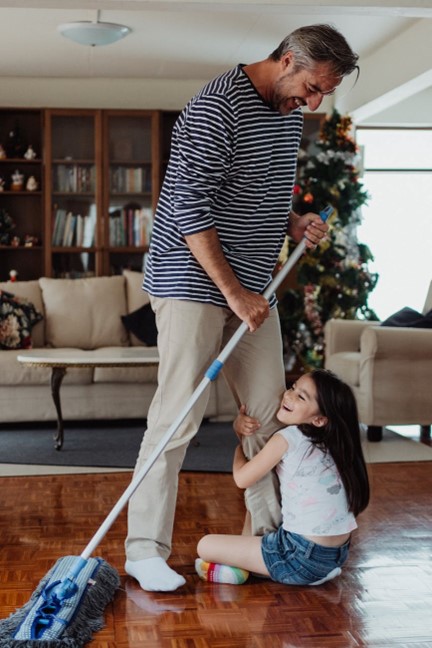
Image by Ketut Subiyanto
In high-traffic areas, like the dining room and kitchen, sweep or vacuum daily. Mop your floors once or twice a week. Mop less-trafficked areas once a month or once a season. Before you mop read “Mop as Needed” below to avoid damaging the wood on your floor.
Vacuuming with a brush attachment is also a great way to remove dirt and dust particles. For heavy-traffic areas, you may need to mop twice a month using the manufacturer’s recommended cleaning product. If you use a vacuum cleaner, make sure to disengage the beater bar or use the “bare floor” setting.
If you have the room in your closet, hardwood floor vacuums are designed to avoid scuffing the floor, and it doesn't have traditional "beater bars" or metal agitator bars. These vacuums have soft rubber or smooth plastic-coated wheels that won't scratch the floor.
How to Mop Hardwood Floors
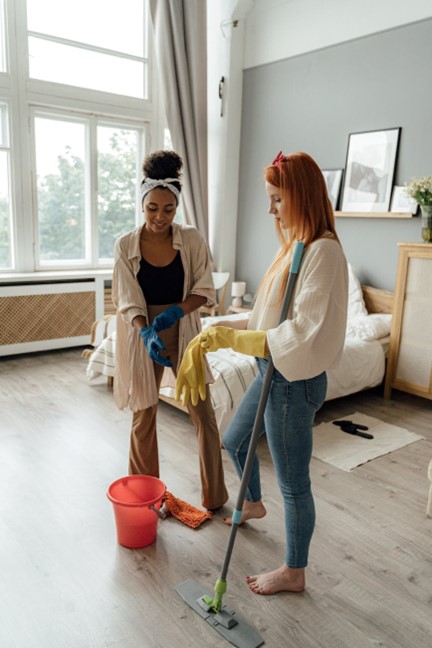
Image by Antoni Shkraba
Donna Smallin Strong, author of "Cleaning Plain & Simple", offered a cautionary warning, "Some manufacturers recommend using water-dampened mops only.
When mopping, it is important to use a damp mop rather than using a wet mop. Make sure to wring out most of the water from the mop before use. Leaving standing water on the wood can cause damage. You can also use a spray-and-mop product or disposable wet pads that are safe for hardwood. Saturate a rag or sponge mop. Then wring it out thoroughly so it is damp rather than wet. Mop with the cleaner, being careful not to leave any puddles behind.
It is best to avoid washing or wet-mopping with soap, water, oil-soap detergent, or any other liquid cleaning materials. These cleaning materials can cause swelling, warping, and surface discoloration.
Spray bottles or a spray mop are easy products to use. They can be sprayed directly onto the floor without leaving behind any puddles. You can buy a good quality spray mop for around $30.00. When you're ready to start cleaning your floors, fill the reservoir with hot water and your favorite floor cleaner. Make sure to wring out the spray mop well before you start cleaning, or you'll end up with puddles of dirty water on your floor.
Are Steam Mops Safe to Clean Wood Floors?

Image by Eva Bronzini
Many people are concerned about the bad effects steam mops may have on their hardwood floors. Reports state that after multiple uses, the finish begins to peel and the wood becomes cloudy and white. Joints in the floor can also turn an ugly grey color with overuse.
It's important to remember that steam is just water vaporized (very hot water), so if you use a steam cleaner on a regular basis it is important not to mix water and wood. Our suggestion is to not use them.
Use the Right Cleaning Products
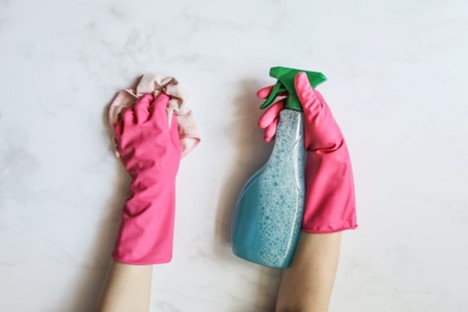
Image by Polina Tankilevitch
When it comes to hardwood floor maintenance, it is important to choose the right cleaning products. Sweeping or dust mopping regularly is the best way to remove dirt and debris from the surface.
Avoid Abrasives and Harsh Chemicals
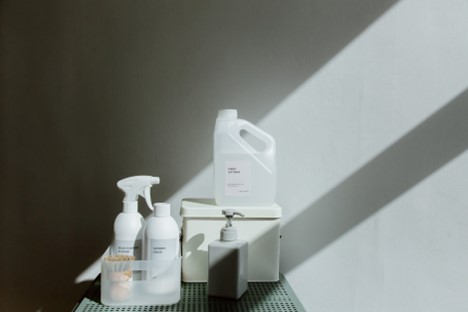
Image by Ron Lach
Many people make the mistake of using harsh chemical cleaners that can damage the finish. Using harsh cleaners or chemicals can cause the finish to become dull and discolored over time and ruin the finish.
Instead, use gentle cleaners specifically designed. A furniture spray such as the Bona Hardwood Floor Spray Mop will do the trick. This furniture spray contains no harmful chemicals and is safe to use on all types of wood.
When it comes time to deep cleaning, you should use a dust mop with a microfiber or terry cloth cover. Use a cleaning solution made specifically for your floor. Avoid using ammonia-based, wax-based, detergents, bleach, polishes, and oil-based cleaners (including oil soap). These can damage your floor finish.
The safest way to remove stuck-on dirt and grime is to use a non-abrasive, pH neutral cleaning solution.
Is it Safe to Use Vinegar to Clean Hardwood Floors?
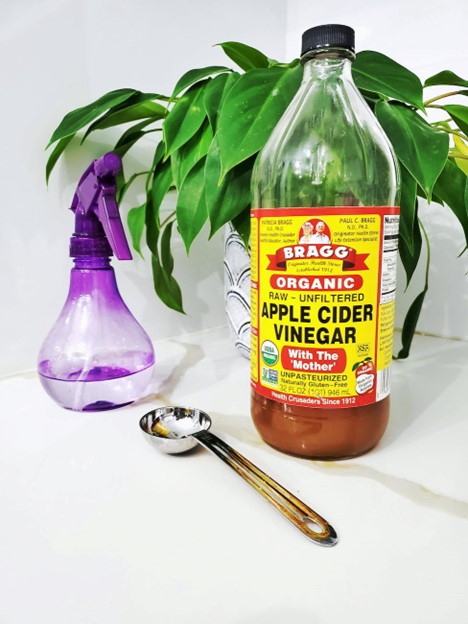
Image by Rosana Solis
If you're looking for a clean and safe way to clean hardwood floors, vinegar was a great option! In past floors people would clean with one part apple cider vinegar mixed with two parts water in a spray bottle and used it on their floors.
However acidic cleaning products such as vinegar can harm your floors finish. No matter what you do, also avoid using vinegar or baking soda solutions. These old-fashioned remedies involving vinegar or dish detergent can't do the same job as today's multi-functional solutions and can actually damage or dull your polyurethane.
For more stubborn dirt and grime buildup, you can use paste wax based products specifically designed for floors. Make sure to follow the manufacturer’s instructions carefully and apply the product evenly across the floor surface. Avoid using oils or any other products.
Remove Stains Immediately
Removing stains immediately is an important part of maintaining their beauty. To remove a stain, you should act quickly and use the right products. Dampen a clean cloth with hydrogen peroxide and press it onto the stain firmly so that the peroxide is absorbed into the wood. Leave the cloth on overnight and then in the morning, remove it and wipe the wood with a damp cloth.
For deeper cleaning, mix together some soap and warm water. Make sure to follow the manufacturer's instructions carefully to ensure that do not damage the wood on your floor. Dry cleaning is also an effective way to clean. Vacuum and clean with a broom regularly and occasionally use a damp, well-wrung-out cloth when needed. Additionally, wipe up spills immediately to prevent them from seeping into the wood.
Keep in mind that water is a dimensional wood’s worst enemy, so never wet-mop or use oil-based soaps. It is also important to avoid abrasives and harsh chemicals when cleaning to prevent damage. Finally, if necessary, call in a professional for help removing stubborn stains or refinishing.
Treat Spills Immediately

Image by Sunsetoned
Spills can stain even freshly sealed hardwood floors, so always get them up as quickly as possible. Clean spills immediately with a dry or slightly damp cloth. Don't use wet mops or steam mops, which will damage the finish and the wood over long periods. Wipe up food and other spills promptly with a dry cloth or paper towel to prevent staining.
Avoid wet mopping as a care technique. Water is a hardwood floor's worst enemy and can seep into the wood. Water can cause warping and discoloration. The moisture content in your wood can't be too high. It's essential to treat spills immediately to avoid long-term damage.
Refinishing Hardwood Floors When Necessary
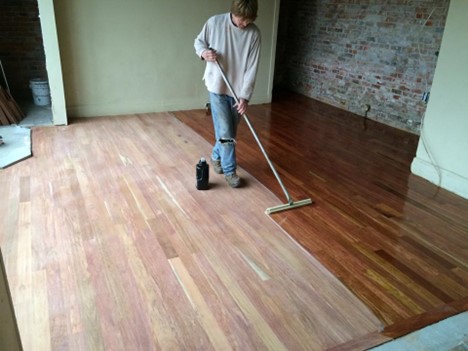
Type image caption (optional)
Refinishing your floor is an important part of keeping them looking their best. This can involve sanding, buffing, staining, and sealing your wood to bring out their natural shine and luster. Doing this periodically can prevent more costly repairs down the road.
Start by prepping the room and patching and repairing any holes or cracks in the wood. Next, sand to remove the top layer of finish. Buff the wood to create a smooth surface. Then, apply a stain (if desired) and sealer to protect the wood from wear and damage.
Use Furniture Pads to Protect Your wood floor
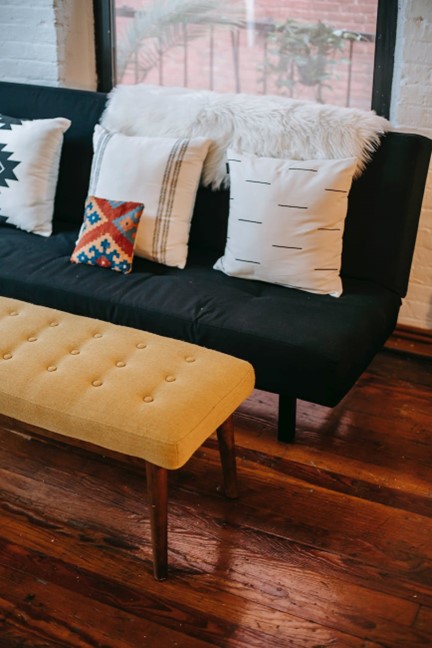
Image by Charlotte May
Place furniture pads under any furniture that sits on top of your wood surface. When it comes to protecting your floor, furniture pads are essential. Furniture pads will prevent your furniture from scratching the wood surface. If you're looking for furniture pads that will protect your floors, be sure to choose one designed specifically for this purpose. Many pads available on the market are not made for this specific type of surface and may cause damage over time.
Also, try to select pads that are slightly larger than the legs of your furniture. Place the pads on each leg of any furniture that sits directly on the wood surface. These pads will provide cushioning and prevent scratches and dents. Additionally, check the pads regularly and replace them when needed.
Place Rugs in High Traffic Areas
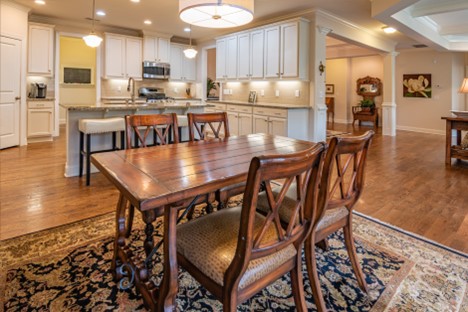
Image by Curtis Adams
Adding rugs and mats to your high-traffic areas can help protect your floor from dirt and debris. Place walk-off mats and area rugs at entrances and high traffic areas, such as hallways, entries, and living rooms. This will help prevent scuff marks and reduce the amount of dirt that comes in contact with your hardwood floor. Make sure to choose rugs and slip-proof mats designed for hardwood floors.
Additionally, it’s important to use walk-off mats outside and inside entrances. The outdoor mats prevent sand and abrasive build-up. Rubber or other dense mat backings should also be avoided.
Clean Up Pet Messes Right Away
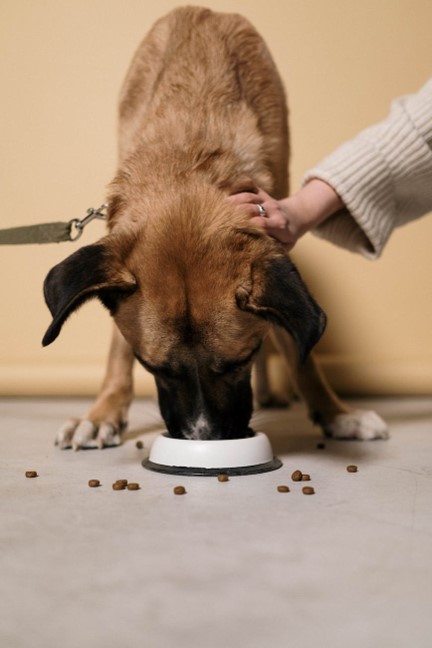
Image by cottonbro studio
Pets can wreak havoc on hardwood floors, so it’s important to clean up any messes they make as soon as possible. Pet urine, feces, and vomit can seep into the wood and cause permanent damage. If you notice a mess, clean it up right away using a pet-safe cleaning product.
Mop the area with warm water mixed with a recommended cleaner and a few drops of grapefruit oil. This will help to remove any lingering odors and disinfect the area. If the pet mess is particularly difficult to remove, call a professional hardwood floor cleaner for assistance.
Avoid Walking on Wet Wood
One of the most important things you can do to protect your hardwood floor is to avoid walking on them while they are wet. This includes not walking on them while they are still wet after mopping. Even though you may think that the floors have dried, it is best to use caution and avoid walking on the floor until they are completely dry.
Additionally, avoid wet mopping your floor. Standing water can cause swelling, warping, and discoloration. If you must mop your hardwood floor, use a damp mop and dry the area immediately. If your flooring gets wet, remove any standing water and use a fan or dehumidifier to dry the area.
Repair Minor Scratches and Dents Promptly
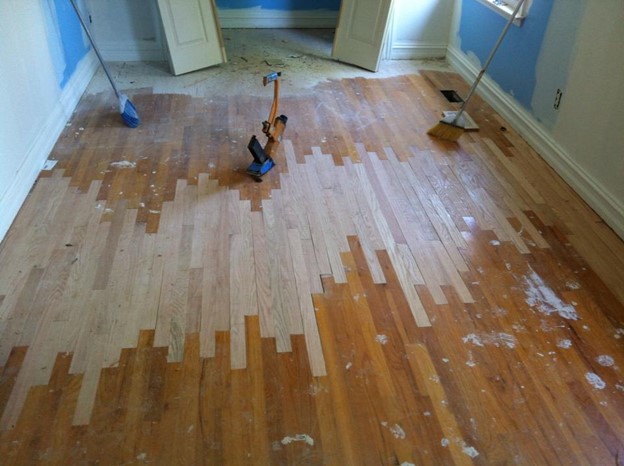
Type image caption (optional)
One of the most important things to remember is to repair minor scratches and dents promptly. Scratches can often be filled in by using wood filler or acrylic filler kits that match the stain of your hardwood.
For deeper scratches, you may need to sand down the floor to remove the scratch. Remember that if your floor starts to look dull or scratched, you may need to refinish it.
If you have any major damage, call a professional for help. We can help you with any questions just reach out to Saddler Wood Floors / (248) 470-7809 Deon@SaddlerWoodFloors.com
Call a Professional if Necessary!
Sometimes, it may be necessary to call a professional to help with the care of your hardwood floor. If you experience any major damage, such as deep scratches or water damage, it may be best to call a hardwood flooring expert. A professional can also help with refinishing your wood floor and provide guidance on proper maintenance. A professional is trained in the correct methods and products for cleaning and maintaining hardwood floors. When you need help with your hardwood floor, be sure to call an experienced professional. We can help you with any questions just reach out to Saddler Wood Floors / (248) 470-7809 Deon@SaddlerWoodFloors.com
Conclusion
In conclusion, a wood floor can last you a lifetime, but not without adequately taking care of them. Keep in mind all these hardwood floor maintenance tips and guidelines to maintain the limited warranties and will prolong the life.
Taking proper care of your investment is essential to ensure they remain in pristine condition for years to come. Vacuum and mop regularly, use the right cleaning products and refinish when necessary. There are many things you can do to keep your hardwood floor looking beautiful.
Be sure to also avoid harsh chemicals and abrasives, as well as place area rugs in high traffic areas and clean up pet messes right away. Finally, if you have any questions or need help with repairs or refinishing, don’t hesitate to contact a professional for assistance. With proper care and maintenance, your hardwood floor will remain stunning for years to come.
If you have any questions about anything from this article or have problems or questions, just reach out to Saddler Wood Floors / (248) 470-7809 Deon@SaddlerWoodFloors.com
